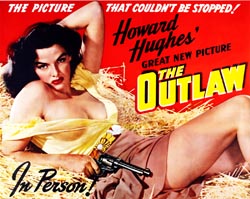
 Sex begins with a kiss, which must be why the 1896 featurette The John C. Rice-May Irwin Kiss — all 47 seconds of it — provoked such a uproar among a puritanical public. Distributed by Thomas Edison’s company, The Kiss (as it is better known) depicted just that and nothing more — a fleeting peck, really, between two completely clothed and consenting adults — yet was viewed as obscene, an affront to Christianity and this country’s very moral fiber.
Sex begins with a kiss, which must be why the 1896 featurette The John C. Rice-May Irwin Kiss — all 47 seconds of it — provoked such a uproar among a puritanical public. Distributed by Thomas Edison’s company, The Kiss (as it is better known) depicted just that and nothing more — a fleeting peck, really, between two completely clothed and consenting adults — yet was viewed as obscene, an affront to Christianity and this country’s very moral fiber.
As Jeremy Geltzer tracks with frightening precision throughout Dirty Words and Filthy Pictures, the then-new art form known as cinema often was targeted as Public Enemy No. 1. This was a time when boxing dramas were perceived as a threat, when courts ruled that film censors did not infringe upon First Amendment rights because the movies were “mere entertainment, not speech worthy of protection.”
Available in both hardcover and trade paperback, the University of Texas Press release finds Geltzer, an entertainment and IP attorney, suggesting that to trace the history of free speech is tantamount to tracing the history of film. He is correct. His story is one of … well, if not good vs. evil, one of good-intentioned vs. evil. As such stories should, the villains bear unique and memorable names like Lloyd T. Binford, Damon Huskey, Judge Michael Musmanno and Maj. Metellus Lucullus Cicero Funkhouser; they just happen to have been real people. The only thing scarier is that they were real people with power, which they wielded to legislate their own narrow worldview and belief system to everyone else.
 From film’s infancy to the legal skirmishes still challenging the pornography industry today, Dirty Words and Filthy Pictures by and large chronologically covers each legislative and/or community battle over the so-called “epidermis epidemic,” documenting each slam of the gavel, every swipe of the censor’s scissors. While the hygiene pictures and porno-chic movement obviously play large parts in this true-life account, so do utterly innocuous works as Howard Hughes’ 1943 Western, The Outlaw, for accentuating Jane Russell’s (covered) bust, and 1955’s Son of Sinbad, another Hughes production, for its inclusion of “lust provoking” dance scenes by stripper Lili St. Cyr, here non-stripped.
From film’s infancy to the legal skirmishes still challenging the pornography industry today, Dirty Words and Filthy Pictures by and large chronologically covers each legislative and/or community battle over the so-called “epidermis epidemic,” documenting each slam of the gavel, every swipe of the censor’s scissors. While the hygiene pictures and porno-chic movement obviously play large parts in this true-life account, so do utterly innocuous works as Howard Hughes’ 1943 Western, The Outlaw, for accentuating Jane Russell’s (covered) bust, and 1955’s Son of Sinbad, another Hughes production, for its inclusion of “lust provoking” dance scenes by stripper Lili St. Cyr, here non-stripped.
Not every controversy was over S-E-X, either. Take Curley, Hal Roach’s 1947 attempt at creating another Little Rascals, which dared depict white kids and black kids as social equals in the classroom. Some things have yet to change.
The sheer number of examples is alarming — just one element that makes Geltzer’s book a great, smart read. As eye-opening as it is pulse-raising, Dirty Words and Filthy Pictures entertains as it informs. It also will surprise you, starting with its foreword by Alex Kozinski: Yes, you really will read, enjoy and appreciate a book whose intro comes from the chief judge of the United States Court of Appeals for the Ninth Circuit. It is ordered! —Rod Lott
